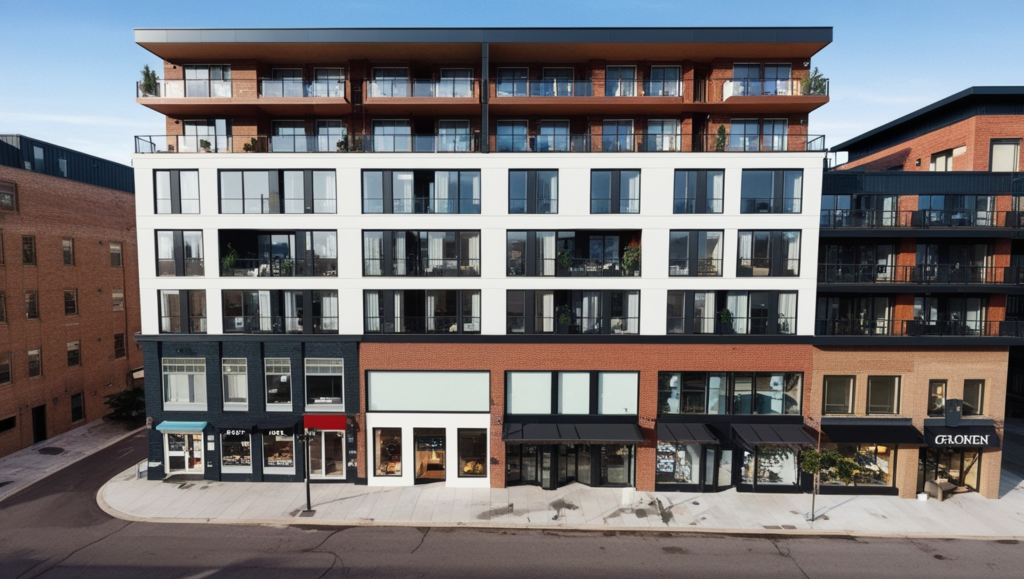Residential real estate investment involves purchasing properties to generate income, build equity, or achieve long-term financial growth. Investors may buy homes to rent them out, renovate and resell them, or hold onto them for appreciation. This type of investment appeals to both new and experienced investors because it provides multiple paths to profitability.
One of the biggest advantages of residential real estate is its ability to generate consistent cash flow. Rental properties can provide passive income while the property itself appreciates in value. Additionally, real estate investments offer tax benefits, including deductions on mortgage interest, property taxes, and depreciation. Unlike stocks or other volatile investments, real estate tends to be more stable, making it an attractive option for those looking to diversify their portfolios.
There are several types of residential real estate investments, each with its own advantages and challenges. Single-family homes offer privacy and potential for appreciation, while multi-family units provide steady rental income from multiple tenants. Condominiums and townhouses appeal to investors seeking lower-maintenance properties, but they come with homeowners association (HOA) fees. Other options, such as vacation homes and student housing, cater to niche markets with unique investment considerations.
Understanding the different property types is essential for making informed investment decisions. Each type requires a different approach in terms of financing, management, and long-term strategy. This guide explores various types of residential real estate investments, highlighting their benefits, risks, and key factors that influence success.
For a more detailed analysis of residential property investment strategies, visit this expert guide.
Types of Residential Real Estate Investments
Investing in residential real estate offers various opportunities, each with its own benefits and challenges. Understanding the characteristics, advantages, and potential risks of different property types can help investors make informed decisions. Below are the most common types of residential real estate investments, along with key considerations for each.
A. Single-Family Homes
Single-family homes are standalone properties designed to house one family or household. These are among the most popular real estate investments due to their accessibility, strong appreciation potential, and ease of management.
Characteristics:
- Pros: High demand, potential for property value appreciation, and greater control over maintenance and management.
- Cons: Vacancies can lead to periods of no rental income. Maintenance and repair costs fall entirely on the owner.
- Typical Investors: Best suited for beginner investors, long-term landlords, and those looking to build wealth through property appreciation.
Investment Considerations:
- Maintenance and repairs are the owner’s responsibility, requiring a budget for unexpected costs.
- Tenant management can be time-intensive, especially without a property manager.
- Single-family homes typically generate rental income from one tenant at a time, increasing vacancy risks.
For insights on how single-family homes compare to other investment options, check out this guide on real estate investing.
B. Multi-Family Units (Duplexes, Triplexes, Apartment Buildings)
Multi-family properties include duplexes, triplexes, and apartment buildings with multiple rental units in a single structure. These properties generate multiple income streams, making them attractive to investors looking for stable cash flow.
Characteristics:
- Pros: Generates income from multiple tenants, reducing financial risk if one unit is vacant. Offers economies of scale—managing multiple units in one building is often more cost-effective than managing multiple single-family homes.
- Cons: Requires more complex management, with multiple tenants to oversee. Initial investment costs are usually higher than single-family properties.
- Typical Investors: Ideal for investors looking for passive income, landlords interested in long-term rental income, and those seeking to scale their real estate portfolio.
Investment Considerations:
- Property management can be challenging due to multiple tenants. Hiring a property manager may be necessary.
- A higher upfront investment is required, making financing and budgeting crucial.
- Maintenance costs are typically higher, but they can be offset by rental income from multiple units.
If you’re considering multi-family properties, learn more about how to maximize rental income with multi-unit investments.
C. Condominiums and Townhouses
Condos and townhouses provide a mix of affordability, convenience, and shared amenities. While they can be great investments, they come with unique challenges like homeowner association (HOA) fees and community regulations.
Characteristics:
- Pros: Lower maintenance since HOAs often handle exterior upkeep and common areas. Amenities like pools, gyms, and security can attract tenants.
- Cons: HOA fees can add significant costs, impacting profitability. Investors have less control over property modifications due to association rules.
- Typical Investors: Suitable for investors looking for lower-maintenance rental properties, those interested in high-demand urban areas, and buyers seeking affordable investment options.
Investment Considerations:
- HOA fees can vary widely and affect the overall return on investment.
- Shared amenities can increase rental demand but may also lead to additional regulations.
- Condos and townhouses are often easier to rent in densely populated areas but may have slower appreciation compared to single-family homes.
For a deeper look into condo and townhouse investing, explore this guide on real estate investment strategies.
D. Other Residential Investments (Vacation Homes, Student Housing, Senior Living, etc.)
Beyond traditional rentals, there are other types of residential real estate investments that cater to niche markets. These properties often require specialized management but can yield higher returns in the right locations.
Characteristics:
- Vacation Homes: High-income potential in tourist-heavy areas but seasonal demand can lead to inconsistent cash flow.
- Student Housing: Located near colleges and universities, these properties offer consistent demand but require frequent tenant turnover and maintenance.
- Senior Living Communities: With an aging population, senior housing investments can provide long-term stability, though they often require specialized property management.
Investment Considerations:
- Market demand fluctuates for vacation rentals, requiring strategic pricing and marketing.
- Student housing investors must be prepared for high turnover and increased wear and tear.
- Senior housing investments may involve additional regulations and licensing requirements.
For more details on niche real estate investments, check out this guide on alternative residential investments.
III. Factors Influencing ROI in Residential Real Estate Investments
Understanding the key factors that impact return on investment (ROI) is essential for making profitable real estate decisions. Several elements determine whether a property will appreciate in value, generate strong rental income, or struggle to provide returns. Investors should focus on three primary areas: location, property characteristics, and market conditions.
A. Location, Location, Location
Location is one of the most critical factors in real estate investment. A property in a desirable area is more likely to attract tenants, appreciate in value, and generate consistent rental income. Several aspects of location influence an investment’s profitability.
- Neighborhood Desirability: The overall appeal of a neighborhood plays a crucial role in determining property demand. Safe areas with low crime rates, well-maintained streets, and attractive surroundings tend to command higher rental rates and resale values. Investors should research crime statistics, local government initiatives, and neighborhood development plans before purchasing.
- School Districts: Access to quality schools significantly affects property values. Families often prioritize neighborhoods with top-rated schools, increasing demand for housing in these areas. Even investors focusing on rental properties should consider school district rankings, as tenants with children often seek rentals in areas with strong educational institutions.
- Amenities and Infrastructure: Proximity to essential amenities such as grocery stores, restaurants, healthcare facilities, and public transportation can impact a property’s desirability. Locations with convenient access to major highways, public transit, and employment hubs are more attractive to renters and buyers. Additionally, areas with parks, entertainment options, and recreational facilities tend to experience higher demand.
B. Property Specifics
The characteristics of a property play a significant role in its profitability. Investors should assess the size, condition, and unique features of a property before making a purchase.
- Size and Layout: The square footage of a home, the number of bedrooms and bathrooms, and the overall layout influence rental income and resale value. Properties with functional floor plans and ample living space appeal to a wider range of buyers and tenants.
- Age and Condition: Older properties may require extensive renovations, increasing upfront costs. However, well-maintained older homes with modern upgrades can still be valuable investments. Investors should conduct thorough inspections to identify potential issues such as outdated electrical systems, plumbing problems, or foundation concerns.
- Special Features and Upgrades: Homes with desirable features—such as energy-efficient appliances, updated kitchens, modern flooring, or smart home technology—can command higher rents and resale prices. Outdoor spaces, such as private yards, patios, or balconies, also enhance property appeal.
C. Market Dynamics
Market conditions heavily influence the success of residential real estate investments. Investors must analyze supply and demand trends, economic factors, and local rental markets to make informed decisions.
- Supply and Demand: A high demand for housing with limited supply leads to property appreciation and strong rental markets. In contrast, an oversupply of homes can lead to stagnating or declining property values. Investors should research housing inventory levels in their target area before purchasing.
- Economic Conditions: The strength of the local economy affects job growth, income levels, and overall housing demand. A region with a thriving job market will attract more residents, increasing rental demand and property values. Conversely, areas experiencing economic downturns may face higher vacancy rates and declining home prices.
- Rental Market Trends: Understanding rental rates and vacancy levels is essential for investors seeking steady cash flow. Areas with high rental demand and low vacancy rates provide stable income opportunities. Researching average rents, tenant demographics, and rental yield percentages can help investors set competitive pricing and maximize returns.
Making Data-Driven Investment Decisions
Investors in Types of Residential Real Estate Investments must evaluate these factors carefully before purchasing a property. Conducting thorough market research, analyzing location desirability, and assessing property features can help maximize returns. Staying informed about economic trends and rental market fluctuations allows investors to make strategic decisions.
For further insights on selecting the right real estate investment, visit this expert guide on real estate investing.

IV. Financial Considerations in Residential Real Estate Investments
Understanding the financial aspects of real estate investing is essential for long-term success. Investors must consider both initial costs and ongoing expenses while evaluating potential rental income and financing options. Careful financial planning ensures profitability and minimizes risk.
A. Initial Costs
Before purchasing a residential investment property, investors must account for several upfront expenses. These costs vary depending on the property type, location, and financing method.
- Down Payment: Most lenders require a larger down payment for investment properties compared to primary residences. Typically, investors need at least 20% of the property’s purchase price. Some financing options, such as FHA or VA loans, may allow lower down payments but have specific eligibility requirements.
- Closing Costs: Buyers must cover expenses like loan origination fees, appraisal fees, title insurance, and attorney fees. Closing costs generally range from 2% to 5% of the property price.
- Renovations and Repairs: Some investment properties need upgrades before they can be rented. Budgeting for repairs, remodeling, or cosmetic improvements is crucial. Costs depend on the property’s condition and the investor’s strategy—whether to flip or hold for rental income.
B. Ongoing Expenses
Once the property is purchased, investors must manage recurring costs. These expenses affect overall cash flow and return on investment.
- Mortgage Payments: If the property is financed, the investor must make monthly mortgage payments, which include principal and interest. A lower interest rate can significantly impact long-term profitability.
- Property Taxes: Taxes vary by location and can increase over time. Investors should research property tax rates in their target markets and factor these costs into their financial calculations.
- Insurance: Landlord insurance protects against property damage, liability claims, and potential loss of rental income. Standard homeowner’s insurance may not provide sufficient coverage for rental properties.
- Maintenance and Repairs: All properties require ongoing maintenance. Routine upkeep, such as landscaping, HVAC servicing, and plumbing repairs, helps preserve property value. Investors should also set aside funds for unexpected repairs, like roof leaks or appliance replacements.
C. Rental Income
Generating rental income is a primary goal for many real estate investors. To maximize profitability, investors must evaluate market conditions and set competitive rent prices.
- Determining Market Rent: Investors should research comparable rental properties in the area to set appropriate rent prices. Factors such as property size, location, and amenities influence rental rates. Online rental platforms and real estate agents can provide market insights.
- Vacancy Rates: Properties may not always be occupied, leading to periods without rental income. Higher vacancy rates can significantly impact profitability. Investors should analyze vacancy trends in their chosen market and develop strategies to attract long-term tenants.
- Cash Flow: Positive cash flow occurs when rental income exceeds expenses, including mortgage payments, taxes, insurance, and maintenance costs. Investors should calculate cash flow projections before purchasing a property to ensure financial sustainability.
D. Financing Options
Investors have several financing options when purchasing residential real estate. The right choice depends on the investor’s creditworthiness, investment strategy, and risk tolerance.
- Traditional Mortgages: Conventional loans offer competitive interest rates, but they typically require higher down payments for investment properties. Lenders also have stricter credit and income requirements for non-owner-occupied properties.
- Government-Backed Loans: FHA and VA loans provide lower down payment options but are generally restricted to owner-occupied properties. Some investors use these loans to purchase multi-family units while living in one unit and renting the others.
- Hard Money Loans: These short-term loans are issued by private lenders and are based on the property’s value rather than the borrower’s credit history. They often have higher interest rates but provide quick access to funding, making them ideal for house flippers.
- Home Equity Loans and HELOCs: Investors who already own property can tap into their home’s equity to finance additional real estate investments. Home equity loans provide a lump sum, while home equity lines of credit (HELOCs) allow flexible borrowing.
- Portfolio Loans: Some lenders offer specialized loans for investors with multiple properties. These loans consolidate multiple mortgages into a single loan, simplifying debt management.
- Seller Financing: In some cases, sellers may finance the property directly, allowing buyers to bypass traditional lenders. Seller financing terms vary and can be negotiated based on the investor’s needs.
For a deeper dive into Types of Residential Real Estate Investments, explore this guide.
V. Legal and Regulatory Landscape in Residential Real Estate Investments
Investing in residential real estate comes with legal responsibilities. Understanding zoning laws, landlord-tenant regulations, and fair housing practices is essential. These laws protect both property owners and tenants while ensuring compliance with local and federal guidelines. Ignoring them can lead to fines, lawsuits, or loss of investment opportunities.
A. Zoning Laws and Building Codes
Zoning laws regulate how land and properties can be used. They determine whether a property can be residential, commercial, or mixed-use. Investors must check zoning regulations before purchasing to ensure the intended use is allowed. Violating zoning laws can result in penalties or forced property modifications.
Building codes set safety and construction standards for properties. They cover structural integrity, electrical systems, plumbing, and fire safety. Investors must ensure properties meet local building codes before renting or selling. Failure to comply can lead to costly repairs, fines, or legal disputes.
For more details on zoning laws and their impact on Types of Residential Real Estate Investments, visit this guide on zoning regulations.
B. Landlord-Tenant Laws
Landlord-tenant laws outline the rights and responsibilities of property owners and renters. These regulations vary by state and city, so investors must stay informed about local requirements.
Key landlord responsibilities include maintaining safe and habitable living conditions, addressing repairs promptly, and respecting tenant privacy. In most areas, landlords must provide advance notice before entering a rental unit. They must also follow legal procedures for security deposits, rent collection, and lease termination.
Tenants also have rights, such as protection from wrongful eviction and the right to live in a safe environment. If a landlord fails to maintain the property, tenants may have legal grounds to withhold rent or terminate the lease. Understanding these laws helps investors avoid legal conflicts and ensures smooth property management.
To learn more about landlord-tenant laws and how they affect Types of Residential Real Estate Investments, explore this legal resource.
C. Fair Housing Practices
The Fair Housing Act prohibits discrimination in housing. It protects renters and buyers from being denied housing based on race, color, religion, sex, disability, familial status, or national origin. Landlords and property owners must ensure fair treatment for all applicants.
Common fair housing violations include refusing to rent to certain groups, setting different rental terms based on personal characteristics, or advertising in a discriminatory manner. Property owners must follow these guidelines to avoid lawsuits and maintain ethical rental practices.
Training in fair housing laws can help investors understand their responsibilities. Many states require landlords to take fair housing courses before renting properties. Following these regulations creates a fair rental market and protects investors from legal action.
For a complete guide on fair housing rules and compliance for Types of Residential Real Estate Investments, check this fair housing guide.
Understanding legal and regulatory requirements is essential for real estate investors. Staying compliant with zoning laws, landlord-tenant regulations, and fair housing practices helps protect investments and ensures ethical property management.

VI. Property Management in Residential Real Estate Investments
Effective property management is essential for maintaining and maximizing returns on residential real estate investments. Whether managing a single-family rental or a multi-unit property, landlords must handle tenant relations, property upkeep, and financial planning. Proper management ensures long-term profitability and minimizes risks.
A. Tenant Screening
Finding reliable tenants is one of the most important aspects of property management. A thorough screening process helps landlords avoid late payments, property damage, and eviction issues.
- Background Checks: Conducting background checks allows landlords to verify a tenant’s criminal history and past rental behavior. This helps assess potential risks before signing a lease.
- Credit Reports: Reviewing credit scores and financial history helps determine whether a tenant can afford rent payments. A strong credit score often indicates financial responsibility.
- Lease Agreements: A legally binding lease agreement outlines the responsibilities of both landlords and tenants. It should include details on rent payments, security deposits, maintenance policies, and lease termination conditions.
B. Maintenance and Repairs
Keeping a rental property in good condition is essential for retaining tenants and preserving property value. Landlords must plan for both routine maintenance and unexpected repairs.
- Handling Repairs: Regular property inspections help identify minor issues before they become costly repairs. Addressing maintenance requests promptly keeps tenants satisfied.
- Preventative Maintenance: Scheduled maintenance, such as HVAC servicing, plumbing checks, and roof inspections, extends the life of property components and reduces long-term expenses.
- Budgeting for Maintenance: Landlords should set aside funds for repairs and property upkeep. A common rule is to allocate 1% to 3% of the property’s value annually for maintenance costs.
C. Dealing with Tenants
Good tenant relationships lead to longer lease agreements and fewer vacancies. Communication, problem-solving, and proper conflict resolution are key skills for landlords.
- Effective Communication: Clear and professional communication helps prevent misunderstandings. Using email, phone, and property management apps can streamline interactions.
- Conflict Resolution: Disagreements over repairs, rent increases, or lease terms may arise. Addressing concerns quickly and fairly can prevent disputes from escalating.
- Handling Evictions: When tenants fail to pay rent or violate lease terms, landlords must follow legal eviction procedures. Understanding local eviction laws ensures compliance and minimizes legal risks.
D. Professional Property Management
For landlords who prefer a hands-off approach, hiring a property management company can simplify operations. However, this comes with added costs.
- Hiring a Property Manager: Property managers handle tenant screening, rent collection, maintenance coordination, and legal compliance. This can be beneficial for investors with multiple properties.
- Associated Costs: Property management fees typically range from 8% to 12% of the monthly rental income. Some companies also charge leasing fees and maintenance markups.
- Weighing the Benefits: While hiring a property manager reduces workload, it also affects overall profits. Investors should compare the costs and benefits before making a decision.
For more insights on effective property management, check out this guide on managing residential real estate investments.
VII. Risks and Challenges in Residential Real Estate Investments
Every investment carries risks, and real estate is no exception. Understanding potential challenges helps investors develop strategies to minimize financial losses and maintain profitability.
A. Vacancy Rates
Vacancy periods can significantly impact rental income. Without tenants, landlords must cover mortgage payments, property taxes, and maintenance costs out of pocket.
- Market Research: Before purchasing a rental property, investors should analyze vacancy rates in the area. High demand locations generally have lower vacancy risks.
- Competitive Pricing: Setting a fair rental price based on market conditions attracts more tenants. Overpricing a property can lead to longer vacancy periods.
- Tenant Retention Strategies: Offering lease renewal incentives, maintaining good landlord-tenant relationships, and keeping the property in excellent condition encourage tenants to stay longer.
B. Property Damage
Unexpected property damage can lead to costly repairs. Some damage results from normal wear and tear, while other cases may involve tenant negligence or environmental factors.
- Insurance Coverage: Landlords should have comprehensive property insurance to cover damages from fires, storms, and other disasters. Tenant insurance can also help protect personal belongings.
- Preventative Maintenance: Regular inspections and timely repairs reduce the likelihood of major structural issues. Proactive maintenance minimizes long-term costs.
- Security Deposits: Collecting a security deposit at lease signing provides financial protection against tenant-related damages. Clearly outlining damage policies in the lease agreement prevents disputes.
C. Economic Downturns
Market conditions can affect rental demand, property values, and overall profitability. Economic downturns may lead to higher vacancy rates and declining property prices.
- Diversification Strategies: Investing in different property types or markets can reduce financial risks during economic downturns.
- Flexible Leasing Terms: Offering month-to-month leases or adjusting rent pricing during economic slowdowns can help attract and retain tenants.
- Long-Term Perspective: Real estate markets fluctuate, but properties often appreciate over time. Investors should focus on long-term gains rather than short-term setbacks.
D. Legal Issues
Owning rental properties involves legal responsibilities. Landlords must comply with housing laws, lease agreements, and fair housing practices to avoid costly legal disputes.
- Tenant Disputes: Issues like unpaid rent, lease violations, and security deposit disputes can lead to legal action. Understanding local landlord-tenant laws helps resolve conflicts legally and efficiently.
- Lawsuits and Liability: If a tenant or visitor is injured on the property due to negligence, the landlord may face legal consequences. Proper insurance coverage and maintaining a safe property environment help mitigate risks.
- Compliance with Regulations: Zoning laws, eviction procedures, and fair housing regulations vary by location. Staying informed about legal requirements prevents potential fines and penalties.
Investors who understand these risks can implement strategies to protect their real estate investments. For a deeper look into risk management, check out this comprehensive guide on mitigating risks in residential real estate investments.

VIII. Investment Strategies in Residential Real Estate
Investors in Types of Residential Real Estate Investments can take different approaches based on their financial goals, risk tolerance, and market conditions. Understanding key investment strategies helps maximize returns while managing potential risks.
A. Long-Term vs. Short-Term Investment
One of the first decisions investors must make is whether to pursue a long-term buy-and-hold strategy or a short-term flipping approach. Each has unique benefits and challenges.
Buy-and-Hold Strategy:
- Investors purchase properties with the intention of holding them for several years.
- Rental income provides ongoing cash flow while the property appreciates in value.
- This approach builds long-term wealth and can be less risky if the property is in a high-demand area.
- However, investors must manage tenants, property maintenance, and market fluctuations.
Flipping Properties:
- Flipping involves buying undervalued homes, renovating them, and selling for a profit within a short period.
- This strategy can generate high returns if the property is improved efficiently and sold in a strong market.
- However, flipping comes with risks, including unexpected renovation costs and market downturns that could reduce profits.
Choosing between these strategies depends on an investor’s financial goals and market conditions. Some may combine both, renting properties for passive income while flipping others for quick gains.
B. Value Investing: Finding Undervalued Properties
Value investing focuses on identifying residential properties that are priced below their true market value. Investors use various techniques to find these opportunities:
- Distressed Properties: Homes in foreclosure or requiring repairs are often priced lower than market value. Investors can renovate them to increase their worth.
- Motivated Sellers: Some homeowners need to sell quickly due to financial hardship, relocation, or personal reasons. This urgency may allow investors to negotiate lower prices.
- Emerging Markets: Investing in areas undergoing economic growth, new developments, or infrastructure improvements can lead to significant appreciation over time.
- Comparative Market Analysis (CMA): Researching local property values and recent sales helps investors determine whether a home is priced competitively.
Value investing requires patience, strong market knowledge, and negotiation skills. When done correctly, it allows investors to acquire properties below market value and build equity quickly.
C. Cash Flow Investing: Generating Positive Monthly Income
Cash flow investing prioritizes generating steady rental income. This strategy ensures that rental revenue exceeds expenses, providing a positive cash flow each month. Key factors to consider include:
- Rental Demand: High occupancy rates in desirable areas increase the likelihood of consistent rental income.
- Operating Costs: Mortgage payments, property taxes, maintenance, and insurance must be factored into the investment analysis.
- Cap Rate and Cash-on-Cash Return: Investors calculate these metrics to evaluate the profitability of a rental property.
- Long-Term Stability: Unlike flipping, cash flow investing provides a predictable income stream and long-term wealth-building potential.
Investors looking for financial stability often prefer cash flow properties in strong rental markets. Proper tenant management and regular maintenance are essential for maintaining profitability.
For more insights on Types of Residential Real Estate Investments, explore this detailed guide.
IX. Tax Implications for Residential Real Estate Investors
Understanding tax rules is essential for maximizing profits and minimizing liabilities. Real estate investors benefit from various tax deductions, capital gains strategies, and incentives that can improve overall returns.
A. Tax Deductions: Reducing Taxable Income
Investors in Types of Residential Real Estate Investments can take advantage of multiple tax deductions, including:
- Mortgage Interest: Interest paid on loans for investment properties is deductible.
- Property Taxes: Annual real estate taxes on investment properties can be written off.
- Depreciation: The IRS allows investors to deduct a portion of a property’s value each year as it ages.
- Operating Expenses: Costs related to maintenance, repairs, property management, and utilities may qualify as deductible business expenses.
These deductions lower taxable income and help investors keep more of their rental earnings. Consulting a tax professional ensures compliance with IRS regulations.
B. Capital Gains: Taxing Profits from Property Sales
When investors sell a property for more than its purchase price, they may owe capital gains tax. The amount depends on how long they held the property:
- Short-Term Capital Gains: Properties sold within one year are taxed at higher rates, based on ordinary income brackets.
- Long-Term Capital Gains: Properties held for over a year qualify for lower tax rates, typically 0%, 15%, or 20%, depending on income.
Investors can reduce capital gains taxes by holding properties longer or using tax-deferral strategies like a 1031 exchange.
C. Tax Strategies: Minimizing Tax Liabilities
Smart tax planning can help real estate investors keep more profits. Common strategies include:
- 1031 Exchange: Allows investors to defer capital gains taxes by reinvesting proceeds from a property sale into a similar property.
- Real Estate Professional Status: Investors who qualify as real estate professionals can deduct more rental property expenses.
- Cost Segregation: Separating property assets (e.g., appliances, fixtures) for accelerated depreciation deductions.
- Retirement Account Investing: Using self-directed IRAs or 401(k)s to invest in real estate offers tax advantages.
Applying these strategies requires careful financial planning. Investors should consult a tax advisor to ensure compliance with federal and state laws.
For an in-depth look at real estate tax strategies, visit this expert resource.

X. Resources and Expert Advice for Residential Real Estate Investments
Investing in residential real estate requires knowledge, strategy, and the right resources. Having access to expert advice can make the process smoother and more profitable. From finding a qualified real estate agent to utilizing online educational platforms, the right guidance can help investors make informed decisions.
A. Real Estate Agents: Finding Qualified Professionals
A knowledgeable real estate agent can be an invaluable resource for investors. They provide market insights, help identify profitable properties, and assist with negotiations. When choosing an agent, look for professionals with experience in investment properties, not just traditional home sales.
- Seek agents who specialize in Types of Residential Real Estate Investments to ensure they understand your goals.
- Check their track record by reviewing past transactions and client testimonials.
- Ask about their familiarity with local market trends, rental demand, and property appreciation.
Many investors find success by working with agents who have personal experience in real estate investing. A well-connected agent can also provide referrals to lenders, inspectors, and property managers. To find a qualified agent, consider searching through the National Association of Realtors (NAR) or local real estate investment groups.
B. Property Managers: Hiring and Working with Professionals
Managing an investment property can be time-consuming. Hiring a property manager can simplify the process, especially for investors who own multiple properties or live far from their rental units.
A property manager handles key responsibilities, such as:
- Tenant screening, including background checks and lease agreements.
- Collecting rent and managing late payments.
- Coordinating maintenance and emergency repairs.
- Ensuring compliance with landlord-tenant laws and local regulations.
Before hiring a property manager, ask about their fee structure, services, and experience with Types of Residential Real Estate Investments. Some charge a flat fee, while others take a percentage of the rental income. Investors can find reputable property managers through the National Association of Residential Property Managers (NARPM).
C. Financial Advisors: Getting Expert Investment Guidance
A financial advisor can help investors create a strategic plan for building wealth through real estate. They offer insights on budgeting, financing options, and tax strategies.
When choosing an advisor, look for professionals with experience in real estate investments. Some specialize in rental property cash flow analysis, while others focus on tax benefits like depreciation and 1031 exchanges.
Key services a financial advisor may provide include:
- Evaluating different Types of Residential Real Estate Investments based on financial goals.
- Assessing loan options and investment financing strategies.
- Planning for long-term wealth accumulation through property appreciation and rental income.
Investors can search for qualified advisors through organizations like the Certified Financial Planner (CFP) Board or consult with real estate investment firms.
D. Online Platforms and Resources: Expanding Your Knowledge
Real estate investors can access a wealth of knowledge through online platforms, books, and courses. Staying informed about market trends and investment strategies can significantly improve decision-making.
Recommended Websites:
- BiggerPockets – A popular platform for real estate education, networking, and investment tools.
- Realtor.com – Provides real estate market insights and property listings.
- HUD.gov – Offers information on government-backed financing options and fair housing laws.
Recommended Books:
- The Millionaire Real Estate Investor by Gary Keller – Covers strategies for building wealth through real estate.
- The Book on Rental Property Investing by Brandon Turner – Focuses on creating passive income through rentals.
- Rich Dad, Poor Dad by Robert Kiyosaki – Highlights financial principles, including real estate investing.
Investors can also take online courses from platforms like Udemy or Coursera to enhance their knowledge of Types of Residential Real Estate Investments.
XI. Conclusion: Making Informed Residential Real Estate Investment Decisions
Investing in residential real estate offers numerous opportunities, but success depends on research, strategy, and expert guidance. Understanding the different Types of Residential Real Estate Investments is the first step. Investors should evaluate property types, financial considerations, and market conditions before making a purchase.
Key Takeaways:
- Work with experienced professionals. A qualified real estate agent, property manager, and financial advisor can provide critical insights.
- Understand the financial aspects. Budgeting for upfront costs, ongoing expenses, and rental income is essential for profitability.
- Stay informed. Market trends, regulations, and investment strategies change over time. Utilizing online resources and expert advice can help investors stay ahead.
- Conduct due diligence. Before purchasing a property, research the location, demand, and potential risks.
With careful planning and the right resources, residential real estate can be a profitable investment. For more insights, check out this complete guide on Types of Residential Real Estate Investments.







